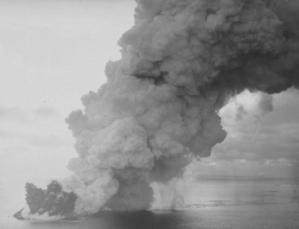© 2006 All Rights Reserved. Do not distribute or repurpose this work without written permission from the copyright holder(s).
Printed from https://danginteresting.com/an-island-is-born/

Off the coast of Iceland on the morning of 14 November 1963, the crew of a lone fishing trawler spotted an alarming sight. Off to the southwest of the Ísleifur II, a column of dark smoke was rising from the water.
Concerned that it could be another boat on fire, the captain directed his vessel towards the scene. Once there, however, they found not a boat but a series of violent explosions producing ash. This was an unmistakable indication of a volcanic eruption taking place underwater, close to the surface.
Very aware of the potential danger but eager to watch, the crew kept their boat nearby. It was indeed a remarkable event that they would witness a small part of over the course of that morning: the formation of a brand-new island.
There had been some geological warning-signs that volcanic activity was about to occur among Iceland’s Vestmannaeyjar (literally, “Westman Islands”). A seismograph in the capital city of Reykjavík had picked up signs of tremors; a marine research team had noted abnormally warm seawater near the site of the eruption; and residents of nearby towns on the coast of the mainland had observed hydrogen sulfide in the air. Certainly the eruption itself had been several days in the making; it would only have become obvious once the volcano had grown to a height at which the water pressure was insufficient to block the explosions.
Although now quite visible, the eruption lasted for much, much longer than the Ísleifur II would have been able to watch. After several days, the volcano had broken the water’s surface, forming an island over 500 meters long and 45 meters tall. Even though the rough tides of the North Atlantic might have soon eroded the new island away, it was named Surtsey, meaning ‘Surtur’s island’ – Surtur (or Surtr) being a fire giant of Norse mythology.

The island proved to be tenacious, however. The eruption was ongoing and Surtsey increased in size more quickly than the ocean could wear it down. In the meantime two other nearby volcanic eruptions produced the beginnings of islands, but neither lasted very long. By April 1964, though, the most violent parts of the eruption were over and Surtsey remained. It was fairly clear that it was going to be a permanent island – or at least as permanent as anything can be in geology.
At this point, the island caught the attention of biologists and botanists. A brand-new island would be an ideal means of studying the process by which plants (and later animals) arrive on and colonize a piece of land. Surtsey was declared a nature reserve in 1965, restricting access severely. No one had really been on the island, aside from a few rogue French journalists from a questionable publication in 1963. That had been early enough in the island’s history not to have made a difference, but now if the public were allowed to set foot on Surtsey, they could unwittingly introduce plant life via the imperceptible transportation of tiny seeds. To this day, only scientists are permitted on the island – and any supplies or equipment carried along have to be handled with a good deal of caution.

The explosions returned in August 1966, and only stopped when the entire eruption finally came to an end in June 1967. Since then, the volcano has lain dormant. The island was left 174 meters tall and about 2.8 square kilometers in size. At 33 kilometers south of the mainland, it also marked the new southernmost point of Iceland.
With that finished, the biocolonization-monitoring project took over. Insects had reached Surtsey by 1964 and moss and lichen had begun to appear between 1965 and 1970; over the next fifteen years, twenty species of plant were observed there, although only half of them lasted in the thin volcanic soil. Gradually, the plant life has become more complex; the number of established plant species has jumped to 30, including one bush first found in 1998.
The emerging plant life helped support the introduction of birds to Surtsey; they began nesting a mere three years after the end of the eruptions. Gulls have been present since 1986, and 2004 saw the discovery of Atlantic puffins. Migrating birds have also used the island as a stopping-place.

The island and its surrounding area have also been host to a variety of marine animals. Seals have bred on the island since 1983 and killer whales have been spotted nearby. Starfish, urchins, and seaweed have also become established on Surtsey.
Today, moss and lichen still make up most of the life on the island, but there has certainly been progress in the way of diversity. Physically, it has decreased a bit in size due to erosion and to the settling of its volcanic material, but is expected to last for centuries to come. Likewise, the invaluable contributions to science from the study of Surtsey are not over yet.
© 2006 All Rights Reserved. Do not distribute or repurpose this work without written permission from the copyright holder(s).
Printed from https://danginteresting.com/an-island-is-born/
Since you enjoyed our work enough to print it out, and read it clear to the end, would you consider donating a few dollars at https://danginteresting.com/donate ?